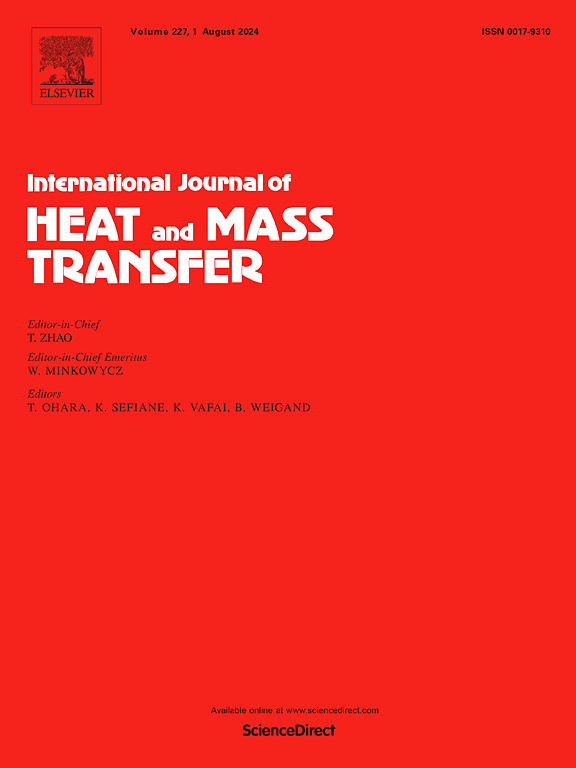作为多孔介质的Gyroid、Diamond和Split-P三周期极小表面的流体动力学特性
IF 5.8
2区 工程技术
Q1 ENGINEERING, MECHANICAL
International Journal of Heat and Mass Transfer
Pub Date : 2025-07-02
DOI:10.1016/j.ijheatmasstransfer.2025.127439
引用次数: 0
摘要
由于其独特的几何特性,三周期最小表面作为工程多孔介质在流体输送和热管理系统中的应用越来越受到关注。然而,准确预测TPMS结构的压降仍然是一个挑战,特别是在过渡流态中。本研究通过使用计算流体动力学模拟来研究Gyroid、Diamond和Split-P几何形状在一系列雷诺数(从粘性到弱惯性)下的流体动力学行为,从而解决了这一空白。使用了两种建模框架:Ergun方程(通常用于充填层)和Darcy-Forchheimer方程(通过新开发的渗透率和惯性阻力因子的相关性进行增强)。渗透率预测还采用了自适应的Kozeny-Carman方程。所开发的相关性,表示为孔隙度和弯曲度的幂律函数,具有很高的准确性,对于大多数配置,相对误差低于10%,对于更复杂的Split-P1几何结构,最大误差为21%。在更大规模的几何形状中进行的验证,如填充TPMS的管道,证实了所提出模型的可扩展性和鲁棒性,即使考虑到由于壁效应导致的水力直径变化。结果表明,Darcy-Forchheimer方程与已开发的渗透率和惯性阻力因子模型具有优越的适用性,特别是对于Split-P等复杂几何形状的模型。相比之下,Ergun方程无法准确预测所研究TPMS的压降,强调了其对这些几何形状的局限性。此外,虽然将扭曲度包含在相关性中提供了额外的细节,但对于所研究的TPMS,它并没有比简单的渗透率-孔隙度关系提供明显的优势,这使得后者在散热器和多孔流动装置等系统的设计和优化应用中成为更实用的选择本文章由计算机程序翻译,如有差异,请以英文原文为准。
Hydrodynamic characterization of Gyroid, Diamond and Split-P Triply Periodic Minimal Surfaces as porous medium
Triply Periodic Minimal Surfaces are gaining significant attention as engineered porous media for applications in fluid transport and thermal management systems due to their unique geometric properties. However, accurate prediction of pressure drop across TPMS structures remains a challenge, particularly in transitioning flow regimes. This study addresses this gap by investigating the hydrodynamic behavior of Gyroid, Diamond, and Split-P geometries using computational fluid dynamics simulations across a range of Reynolds numbers, from viscous to weakly inertial regimes. Two modeling frameworks were utilized: the Ergun equation, commonly used for packed beds, and the Darcy-Forchheimer equation, enhanced with newly developed correlations for permeability and inertial drag factor. An adapted Kozeny-Carman equation was also applied for permeability prediction. The developed correlations, expressed as power-law functions of porosity and tortuosity, demonstrated high accuracy, with relative errors below 10 % for most configurations and a maximum error of 21 % for the more complex Split-P1 geometry. Validation in larger-scale geometries, such as pipes filled with TPMS, confirmed the scalability and robustness of the proposed models, even when accounting for variations in the hydraulic diameter due to wall effects. The results demonstrate the superior suitability of the Darcy-Forchheimer equation with the developed permeability and inertial drag factor models, particularly for complex geometries like Split-P. In contrast, the Ergun equation fails to accurately predict pressure drop across the investigated TPMS, underscoring its limitations for these geometries. Furthermore, while the inclusion of tortuosity in the correlations provides additional detail, it does not offer significant advantages over the simpler permeability-porosity relation for any of the investigated TPMS, making the latter a more practical choice for design and optimization applications in systems such as heat sinks and porous flow devices
求助全文
通过发布文献求助,成功后即可免费获取论文全文。
去求助
来源期刊
CiteScore
10.30
自引率
13.50%
发文量
1319
审稿时长
41 days
期刊介绍:
International Journal of Heat and Mass Transfer is the vehicle for the exchange of basic ideas in heat and mass transfer between research workers and engineers throughout the world. It focuses on both analytical and experimental research, with an emphasis on contributions which increase the basic understanding of transfer processes and their application to engineering problems.
Topics include:
-New methods of measuring and/or correlating transport-property data
-Energy engineering
-Environmental applications of heat and/or mass transfer

 求助内容:
求助内容: 应助结果提醒方式:
应助结果提醒方式:


